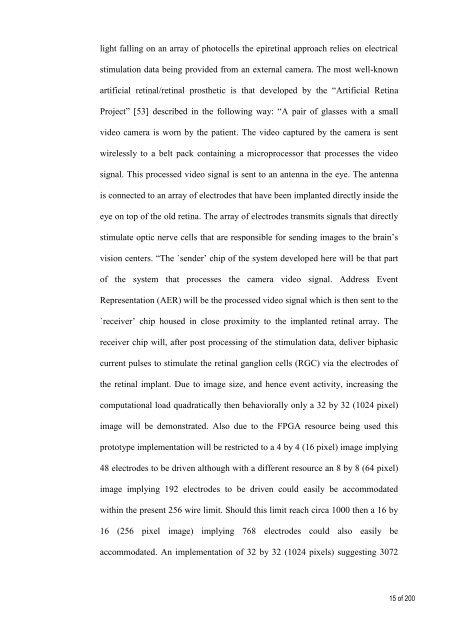Retinal Prosthesis Dissertation - Student Home Pages
Retinal Prosthesis Dissertation - Student Home Pages
Retinal Prosthesis Dissertation - Student Home Pages
You also want an ePaper? Increase the reach of your titles
YUMPU automatically turns print PDFs into web optimized ePapers that Google loves.
light falling on an array of photocells the epiretinal approach relies on electrical<br />
stimulation data being provided from an external camera. The most well-known<br />
artificial retinal/retinal prosthetic is that developed by the “Artificial Retina<br />
Project” [53] described in the following way: “A pair of glasses with a small<br />
video camera is worn by the patient. The video captured by the camera is sent<br />
wirelessly to a belt pack containing a microprocessor that processes the video<br />
signal. This processed video signal is sent to an antenna in the eye. The antenna<br />
is connected to an array of electrodes that have been implanted directly inside the<br />
eye on top of the old retina. The array of electrodes transmits signals that directly<br />
stimulate optic nerve cells that are responsible for sending images to the brain’s<br />
vision centers. “The `sender’ chip of the system developed here will be that part<br />
of the system that processes the camera video signal. Address Event<br />
Representation (AER) will be the processed video signal which is then sent to the<br />
`receiver’ chip housed in close proximity to the implanted retinal array. The<br />
receiver chip will, after post processing of the stimulation data, deliver biphasic<br />
current pulses to stimulate the retinal ganglion cells (RGC) via the electrodes of<br />
the retinal implant. Due to image size, and hence event activity, increasing the<br />
computational load quadratically then behaviorally only a 32 by 32 (1024 pixel)<br />
image will be demonstrated. Also due to the FPGA resource being used this<br />
prototype implementation will be restricted to a 4 by 4 (16 pixel) image implying<br />
48 electrodes to be driven although with a different resource an 8 by 8 (64 pixel)<br />
image implying 192 electrodes to be driven could easily be accommodated<br />
within the present 256 wire limit. Should this limit reach circa 1000 then a 16 by<br />
16 (256 pixel image) implying 768 electrodes could also easily be<br />
accommodated. An implementation of 32 by 32 (1024 pixels) suggesting 3072<br />
15 of 200
















